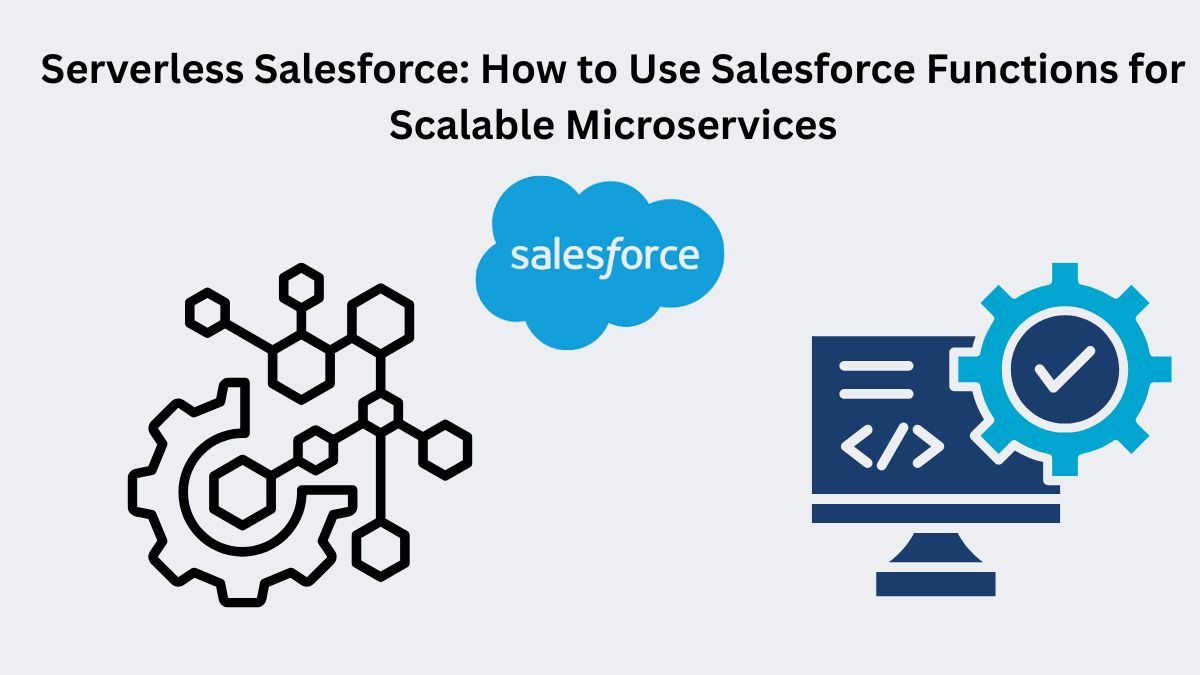Serverless Salesforce: How to Use Salesforce Functions for Scalable Microservices

Strong 8k brings an ultra-HD IPTV experience to your living room and your pocket.
The evolution of enterprise platforms has reached a point where scalability, modularity, and speed are no longer optional—they are foundational. As businesses embrace microservices architecture to break down monolithic systems into manageable, independent components, Salesforce has introduced a compelling solution to support this transition: Salesforce Functions. By enabling serverless computing within the Salesforce ecosystem, this feature brings new levels of flexibility, scalability, and performance to application development.
Salesforce Functions allows developers to write code in a range of modern languages like JavaScript and Java, run it securely on Salesforce’s infrastructure, and invoke it from anywhere within the Salesforce Platform. This serverless architecture shifts the burden of resource provisioning, scaling, and management away from the developer, allowing more focus on business logic and less on infrastructure.
Understanding the Shift Toward Microservices
Microservices architecture revolves around designing applications as a suite of small, independent services. Each service typically manages a specific business capability and communicates over lightweight APIs. Compared to traditional monolithic designs, microservices offer greater flexibility in development, deployment, and scaling.
Incorporating microservices into a Salesforce-centric application stack enables enterprises to:
* Decouple tightly bound processes for easier maintenance
* Scale individual services based on demand
* Update specific components without affecting the entire system
However, until recently, running microservices directly on Salesforce required complex integrations with external platforms or middleware. Salesforce Functions changes this paradigm.
What Are Salesforce Functions?
Salesforce Functions are event-driven, serverless functions that run on Salesforce’s managed infrastructure. Developers can write functions using industry-standard tools and languages (currently JavaScript, TypeScript, and Java), and deploy them as part of Salesforce DX projects.
These functions are tightly integrated with Salesforce data and metadata. This means they can be invoked from Apex, Flow, or even via REST APIs—while also maintaining the scalability and operational efficiency of serverless computing.
Key Benefits of Salesforce Functions:
Elastic scalability: Automatically scales with workload demands.
Seamless Salesforce data access: Functions run with secure access to your org’s data model.
Reduced operational overhead: No need to manage servers or containers.
Language flexibility: Support for modern programming languages outside of Apex.
This combination makes Salesforce Functions an ideal tool for implementing scalable microservices directly within the Salesforce ecosystem.
Microservices with Salesforce Functions: Architectural Use
In a typical Salesforce-powered architecture, many operations—from heavy calculations to third-party API calls—can overload the platform if not handled externally. Traditionally, such tasks required separate backend services or middleware hosted on platforms like AWS or Heroku. Salesforce Functions provides a native alternative.
Here’s how Salesforce Functions fit into a microservices design:
Function as a Service (FaaS): Each function encapsulates a microservice, such as tax calculation, inventory validation, or external data enrichment.
Stateless execution: Functions execute independently and do not maintain any state between invocations, adhering to microservices principles.
API-driven: Functions expose callable interfaces, allowing them to be triggered via REST, event bus, or programmatically from within Salesforce.
This modular approach supports clean, domain-driven application architecture while leveraging Salesforce’s powerful CRM foundation.
Development Workflow with Salesforce Functions
To build and deploy serverless microservices using Salesforce Functions, developers typically follow this process:
1. Create the Function using Salesforce DX CLI or VS Code with Salesforce Extensions.
2. Write the logic using supported languages (JavaScript or Java).
3. Deploy to compute environment, where Salesforce handles infrastructure and scaling.
4. Invoke the Function from Apex, Flows, or REST endpoints.
This model enables developers to overcome common limitations in Apex, such as governor limits or long-running operations, by offloading heavy logic to functions that execute outside of the Salesforce runtime.
Sample Use Cases:
* Complex data transformations
* Asynchronous integration with external systems
* Data enrichment or cleansing operations
* Long-running batch processing
These functions can be version-controlled, tested independently, and scaled elastically based on demand—all aligning with microservices best practices.
Where Salesforce Consulting Services Add Value
While Salesforce Functions offer immense flexibility and power, designing and implementing an efficient microservices architecture can be complex. This is where specialized Salesforce consulting services come into play. Skilled consultants help businesses:
* Assess readiness for microservices adoption
* Identify suitable processes to externalize using Functions
* Architect secure, scalable, and compliant solutions
* Establish DevOps pipelines and best practices for deployment
Moreover, consulting experts can help bridge the gap between Apex development and modern JavaScript/Java practices, ensuring a cohesive development approach. Whether your team lacks experience with serverless computing or needs guidance on integrating Functions into existing CRM workflows, Salesforce consultants provide the strategic and technical support needed to execute a robust solution.
Considerations for Using Salesforce Functions
Though powerful, Salesforce Functions are not a one-size-fits-all solution. Developers and architects must evaluate when and how to use them strategically. Key considerations include:
Latency: Serverless functions may introduce slight delays compared to synchronous Apex.
Complexity: Requires familiarity with external programming languages and CLI tools.
Cost management: Functions are usage-based and may incur higher costs if not optimized.
Security and compliance: Requires careful handling of data, especially in regulated industries.
As with any serverless solution, planning for observability, logging, and monitoring is essential. Salesforce provides tools and best practices, but teams must ensure they are implemented effectively.
Looking Ahead: The Future of Serverless on Salesforce
Salesforce Functions represent a major step toward modernizing how developers build on the platform. As the ecosystem evolves, we can expect deeper integration with other Salesforce features like Event-Driven Architecture (EDA), Platform Events, and Pub/Sub APIs.
By combining Functions with other cloud-native patterns—such as event sourcing, CQRS, and domain-driven design—enterprises can create truly modular systems that evolve rapidly with market needs.
As organizations look to scale their CRM and automation capabilities without increasing platform complexity, the use of microservices through Salesforce Functions offers a compelling path forward.
Conclusion
Salesforce Functions brings the benefits of serverless computing to the Salesforce ecosystem, making it easier to build and scale microservices natively. Whether you're breaking apart a monolithic process or extending the platform with external logic, Functions provide a clean, efficient, and scalable way to do so. For businesses aiming to modernize their architecture, especially those already invested in Salesforce, the serverless model opens the door to faster innovation, better performance, and reduced operational overhead.
However, realizing these benefits requires more than just tools—it requires expertise. That’s where Salesforce consulting services become invaluable, helping translate vision into architecture, and architecture into action. With the right approach and skilled guidance, Salesforce Functions can become the backbone of a modern, agile CRM strategy.
Note: IndiBlogHub features both user-submitted and editorial content. We do not verify third-party contributions. Read our Disclaimer and Privacy Policyfor details.


